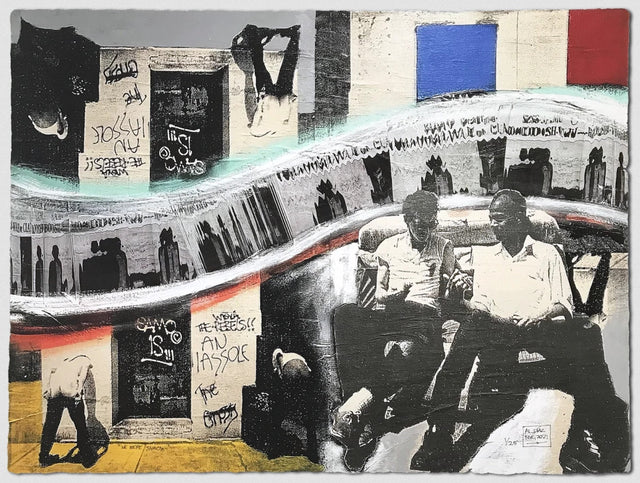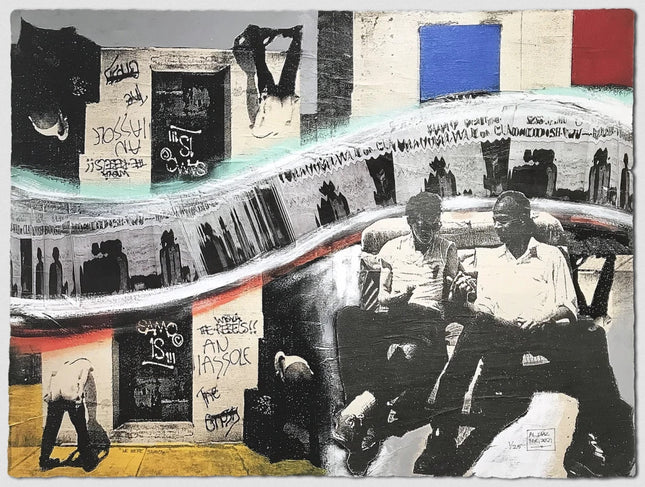
SAMO©

Al Diaz SAMO©… Reclining on a Car Seat, West Broadway, 1978 Archival Print by Al Diaz
SAMO©...Reclining on a Car Seat, West Broadway, 1978 Archival Pigment Fine Art Limited Edition Print on 310gsm Hahnemühle William Turner Matte Fine Art Paper by Modern Pop Street Graffiti Artist Al Diaz. Al Diaz "SAMO©...Reclining on a Car Seat, West Broadway, 1978" - Limited Edition of 25 - 18 x 24" SAMO©...RECLINING ON A CAR SEAT, WEST BROADWAY, 1978 • Autographed archival pigment print • Printed on Hahnemühle William Turner matte fine art paper, 310 GSM • Custom hand-torn deckled edges • Hand-varnished • 18 x 24 inches Hand-signed, numbered and dated in ink by Al Díaz in a limited edition of 25 • With additional "WE WERE SAMO©..." ink inscription
$489.00

SAMO©, which stands for "Same Old Shit," was an informal graffiti tag and art collaboration between American artists Jean-Michel Basquiat and Al Diaz in the late 1970s. The duo created enigmatic, poetic, and often sarcastic phrases that they spray-painted on the walls and buildings of New York City, particularly in the Lower East Side and Soho neighborhoods. Jean-Michel Basquiat (1960-1988) later became a prominent Neo-Expressionist and Primitivist painter in the 1980s art scene. His art focused on themes such as race, social critique, and pop culture, and he often incorporated text and symbols in his work. Although the SAMO© collaboration came to an end around 1980, Basquiat continued to reference it in his solo work. Al Diaz is an artist who has continued to work in various mediums such as painting, sculpture, and mixed media. He has also participated in collaborative street art projects and has exhibited his work in galleries and museums. SAMO© began as a way for Jean-Michel Basquiat and Al Diaz to express their disillusionment with the art world, consumer culture, and societal norms. The two met while attending the alternative high school, City-As-School, in Manhattan. They initially used the SAMO© tag to make their mark on the city, creating a distinct identity for their work. The cryptic messages they left around New York City often combined humor, social commentary, and a rebellious attitude. The partnership between Basquiat and Diaz did not last long. By the time Basquiat started gaining recognition in the art world, SAMO© had come to an end. In 1980, Basquiat famously spray-painted "SAMO© IS DEAD" on the walls of SoHo, signifying the end of their collaboration. However, the influence of SAMO© remained present in Basquiat's later works, as he continued to incorporate text, symbols, and social commentary into his paintings. After the dissolution of SAMO©, Basquiat's career took off, and he became one of the most prominent artists of the 1980s. His friendships and collaborations with other well-known artists, such as Andy Warhol, further propelled his status in the art world. Basquiat's artwork has since become highly sought after, with his pieces fetching millions at auction. Al Diaz, though less prominent than Basquiat, has continued to be active in the art world. His work in various mediums demonstrates a commitment to his artistic vision and exploration. Diaz has also been involved in art collectives and has participated in group exhibitions. In recent years, he has revisited the SAMO© concept, creating new works and installations inspired by the original project. The SAMO© project remains an important part of New York City's art history and is emblematic of the creative energy and countercultural spirit that characterized the late 1970s and early 1980s. As both Basquiat and Diaz went on to pursue their individual artistic careers, the impact of their collaboration can still be seen in their respective bodies of work. The legacy of SAMO© has also influenced later generations of street artists and graffiti writers, who have incorporated text, social commentary, and humor into their work. The cryptic, thought-provoking phrases and messages of SAMO© served as a precursor to the more conceptual and politically-charged street art that has emerged in the decades since.

